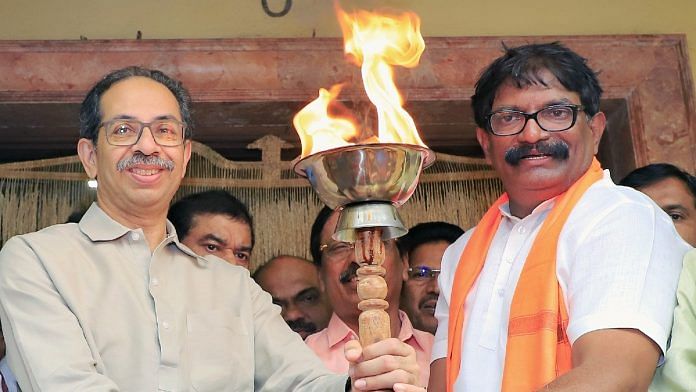New Delhi: Disputes over the newly-assigned election symbols of the two Shiv Sena factions continue, with the Samata Party moving the Delhi High Court Saturday over the mashaal (flaming torch) symbol assigned to the Uddhav Thackeray-led Shiv Sena — Uddhav Balasaheb Thackeray party by the Election Commission (EC) earlier this week.
The Samata Party, which was derecognised by the EC in 2004, had also filed a complaint to the Commission over its “original symbol” being assigned to Uddhav’s party.
The Samata Party was formed in 1994 by Bihar Chief Minister Nitish Kumar and the late leader, George Fernandes. In 2003, Fernandes announced its merger with the Janata Dal (United), but the idea was opposed by the party’s MP, Brahmanand Mandal.
The Election Commission too did not officially recognise the merger, and the Samata Party was derecognised in 2004. The Election Commission can derecognise a party if it does not receive at least six per cent of votes or win a minimum of two seats in state elections.
For national parties, it is mandatory to have received a minimum of six per cent votes and to have MLAs in at least four states.
While earlier derecognised parties would lose their symbols, the EC modified the rules in 1997 to allow the parties to reserve their symbol.
Samata Party president Uday Mandal told ThePrint that the symbol of mashaal was reserved by the Samata Party, and it was freed just in a day without informing the party, and allocated to Uddhav Thackeray’s party.
“We were not notified by the EC that our reserved symbol was being allocated to another party. We are preparing for Bihar elections in the future and we would need our original symbol,” said Mandal.
He added: “The EC did not respond to our complaint, which was filed two days ago. So now we are approaching the Delhi High Court with a plea to let us retain our original symbol.” According to the party leader, after being derecognised they had fought some state elections using the ‘battery torch’ and ‘air conditioner’ symbols, while the mashaal remained reserved.
ThePrint reached the Election Commission spokesperson over phone for comment on the dispute over the symbols, but received no response till the time of publication of this report.
Meanwhile, the spokesperson of the Shiv Sena — Uddhav Balasaheb Thackeray party, Manisha Kayande, said that maybe the Samata party is trying to return to the picture and feel relevant. “They were derecognised in 2004, so maybe they are looking at this as an opportunity to get recognised among people. The mashaal symbol was allocated to us by the Election Commission and they must have verified before allocating the election symbol,” she told ThePrint.
Mandal on his part clarified that the Samata Party wanted the EC or the judiciary to take note of their objection on the symbol because the Andheri by-polls in Mumbai are scheduled for next month, and if once Uddhav’s party fought the elections with the mashaal symbol, it would be difficult for the Samata Party to claim it back.
Also read: Smarting over Shinde rebellion, Uddhav makes peace with Sena’s first rebel, Chhagan Bhujbal
Sikh group claims Shinde party symbol resembles Khalsa symbol
Not just the Uddhav’s party. The rebel faction of the Shiv Sena led by Maharashtra Chief Minister Eknath Shinde, which has been named the Balasahebanchi Shiv Sena and allocated the election symbol of ‘two sword and a shield’, has drawn the ire of a Sikh group from Nanded, which claimed it resembles the Khalsa symbol.
The Balasahebanchi Shiv Sena’s original demand for a “trishul” or “gada (mace)” as a symbol had been turned down by the EC due to their religious connotations.
Now, Ranjit Singh Kamthekar, former secretary of Sachkhand Gurudwara Board in Nanded, has reportedly sent a letter to the Election Commission that the Balasahebanchi Shiv Sena symbol should not be used as an election symbol as it resembles the religious symbol of the Khalsa community.
While no response has been received by ThePrint from the EC as mentioned above, the Balasahebanchi Shiv Sena spokesperson, Naresh Mhaske, told ThePrint, however, and said every symbol has some historical or religious significance.
“It was allocated to us by the EC. We anyway wanted the original ‘teer and kamaan’ (symbol of the Shiv Sena), but the fight will continue. This is a temporary symbol and we would try our best to get the ‘teer and kamaan’ as our election symbol,” he said.
In June, Shiv Sena MLA Eknath Shinde led a rebellion of Sena MLAs to topple the Thackeray-led Maha Vikas Aghadi (MVA) government — an alliance of the Shiv Sena, the Nationalist Congress Party and the Congress — and come to power in partnership with the Bharatiya Janata Party (BJP).
While both parties had laid claim to the Shiv Sena name and its “bow and arrow” symbol, the EC had asked the two to choose alternate names and symbols instead.
(Edited by Poulomi Banerjee)
Also read: Arch rivals to allies: Thackeray Sena embraces CPI support for crucial Andheri East bypoll



